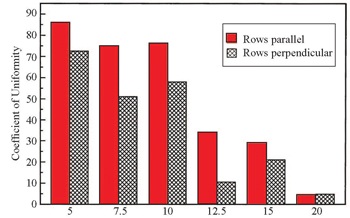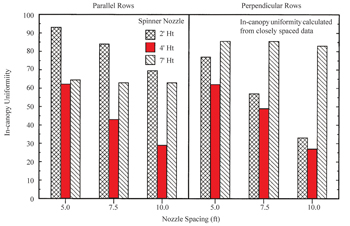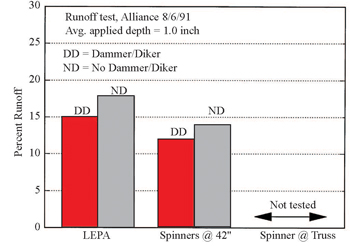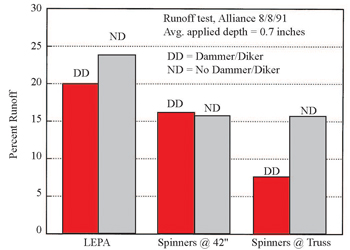G1712
Application Uniformity of In-Canopy Sprinklers
Use of in-canopy sprinklers can reduce application uniformity and increase runoff. Learn how to evaluate the efficiency of in-canopy sprinklers.
C. Dean Yonts, Extension Irrigation Engineer
William L. Kranz, Extension Irrigation Specialist
Derrel L. Martin, Irrigation and Water Resources Specialist
- Application Uniformity Using In-canopy Sprinklers
- In-Canopy Water Distribution
- Water Application Efficiency
- Above-Canopy and In-Canopy Water Application Example
- Summary
- References
- Acknowledgment
The goal, when using center pivot irrigation, is to uniformly distribute water on the soil surface. Uniform application of water combined with uniform infiltration of water into the soil gives plants equal access to water. As a method to reduce energy costs, many producers have converted their center pivot systems from high to medium or low pressure sprinkler packages. As a result, sprinkler manufacturers continue to develop new devices for use above and below the center pivot pipeline to uniformly apply water at lower pressures. On the positive side, lowering the operating pressure of a sprinkler system can reduce pumping costs. On the negative side, lower operating pressure reduces the sprinkler-wetted diameter.
Wetted diameter is defined as the distance across a water application pattern from dry soil in front of the system to dry soil behind the system. The wetted diameter defines a circular area that is wetted by a single sprinkler device and by a series of overlapping sprinkler devices. In addition to the sprinkler device selected, operating pressure of the irrigation system and height of operation are factors in determining wetted diameter. Wetted diameter decreases most significantly with lower operating pressure. As a result, the rate at which water is applied to the soil increases. This increase in water application rate can in turn cause runoff due to the soil’s inability to take in the water fast enough.
When sprinkler devices are placed much below the truss rods, and corn is being grown, in-canopy sprinkler operation results. A sprinkler device operated within the crop canopy further reduces wetted diameter as a result of crop leaves interfering with the trajectory of water droplets. Our intuition would tell us that dropping the sprinkler device into the crop canopy will simultaneously reduce evaporation. Research, however, has shown the potential for reducing evaporation is small when changing from above-canopy to in-canopy operation. Consider the following questions before making changes:
- What happens to application uniformity when sprinklers are used in-canopy?
- What impact does application uniformity of in-canopy sprinklers have on water application efficiency?
- What is the cost of placing sprinkler devices in-canopy as opposed to above-canopy?
- What happens to the ability to chemigate and apply chemicals uniformly?
Application Uniformity Using In-canopy Sprinklers
|
Many low-pressure sprinkler devices have been designed to operate on drop tubes below the pipeline. However, few are designed specifically to operate within the crop canopy. As part of Low Energy Precision Application (LEPA) systems, drop tubes are used to place water at or near the soil surface. LEPA, a system that incorporates planting in a circle and placing drop tubes in every other row, compensates for high water application rates by constructing furrow storage reservoirs to prevent runoff and maintain infiltration uniformity.
In-Canopy Water Distribution
The coefficient of uniformity is a measure of how evenly water is distributed over the area where water is being applied. Results from a Kansas study, (Figure 1) shows the coefficient of uniformity of six nozzle spacings for spray heads located 12 inches above the ground in growing corn. As a reference, a uniformity coefficient of 90 or greater is the normal level to which manufacturers expect sprinkler devices on center pivots to perform. A sprinkler device design that gives anything less would be considered substandard. In this study, corn was planted both parallel and perpendicular to the sprinkler line of travel, and as shown in the figure, none of the configurations meet the 90 or greater criteria for uniformity coefficient. As would be expected, when nozzle spacing increased, the coefficient of uniformity decreased.
The parallel row orientation, simulating corn planted in a circle, had uniformity coefficients of 70 or more for spacings up to 10 feet. When the sprinklers moved perpendicular to the rows, the coefficient of uniformity was reduced even further for all nozzle spacings. This row orientation would simulate the majority of a field when corn is planted in straight rows. Based on today’s technology, five-foot spacing with parallel row orientation is only marginally acceptable and this design requires a large number of nozzles to be installed on a system.
In another Kansas study, Spinners were installed at three different heights and spacings in perpendicular and parallel rows, Figure 2. In-canopy uniformity was always worst at the 4-foot height where leaves are most abundant and ears are located. Spinners, at a height of 2 feet, were better in a parallel row orientation. The 7-foot height was better for the perpendicular orientation because of less distortion of the sprinkler pattern.
In a Nebraska study, soil water content was measured in mature corn to evaluate the uniformity of water distribution. Spinners were spaced 12.5 feet apart at a height of 42 inches in mature corn. Soil water content was measured in the top 12 inches of soil before and after irrigation. The system was moving parallel with the corn rows but Spinners were not necessarily between the corn rows. Figure 3 shows the location of the sprinklers in the corn and the change in soil water content. Soil water content increased about 11 percent in the rows nearest the sprinkler device. In the rows centered between the sprinkler devices, the soils water content increased by an average of only 2 percent. The small change in soil water content indicates the rows between the sprinkler devices received little or no water during the irrigation event. The wetted radius in this case is assumed to be no better than about half the distance between the sprinkler devices. This is about 6 feet, or a little more than two 30-inch rows of corn. While this indicates a wetted diameter of 12 feet, the sprinkler device used here is capable of delivering a wetted diameter of about 40 feet.
These studies demonstrate the variability in water application as a result of in-canopy irrigation. Poor uniformity resulted regardless of nozzle height even if nozzles were closely spaced, 5 feet. Crop yields may or may not be influenced since soil has the ability to redistribute some of the water that is not uniformly applied. However, it would be difficult to uniformly redistribute all of the water in the soil given the water application pattern shown in Figure 3 and the rapid use of water by a growing crop. The reduced uniformity of these studies is due to in-canopy interference and does not reflect performance of Spinners or other sprinkler devices.
Water Application Efficiency
As an irrigation system passes a given point in the field, the application rate gradually increases for the first half of the application and then decreases. If properly designed, the peak system application rate should be approximately equal to the soil infiltration rate. If the application rate of the irrigation system exceeds the infiltration rate of the soil, surface ponding will occur. If the application rate does not exceed the infiltration rate and surface storage capacity, water will pond until infiltration is completed. If application exceeds the infiltration rate and surface storage capacity of the soil, runoff will result.
In a second Nebraska study, runoff was measured from three different systems; a LEPA system with bubblers located at 18 inches, Spinners located 42 inches above the ground, and Spinners located above the corn canopy at the truss rods. A comparison also was made between normal cultivation and furrow diking. Field slope varied between 1 and 3 percent. The results of these studies are shown in Figures 4 and 5. The LEPA system resulted in 15 percent to 25 percent runoff from both irrigation events. The Spinners located at 42 inches had runoff of 12 percent to 16 percent. Even Spinners located above the canopy and using furrow diking had runoff of about 8 percent.
The amount of runoff when 0.7 inches of water was applied and the Dammer-Diker was used (Figure 5) decreased from 15 percent at 42 inches to 8 percent at truss rod height. Only 1 to 2 percent savings in evaporation losses can be expected when sprinkler devices are moved from immediately above to within the crop canopy. The result, is that water lost to runoff cannot be made up through evaporation savings.
Comparing the LEPA system with the above-canopy devices resulted in runoff being reduced from 20 percent to 8 percent. Based on Texas data, a 10 percent savings in water application can be achieved when using a LEPA system, compared to using above-canopy devices. In this soil type and slope, trying to save 10 percent of the water using LEPA reduced application efficiency by 12 percent due to runoff. In either case, the water runoff loss was unacceptable.
The LEPA system has been demonstrated in some areas as one method to uniformly apply water within the crop canopy and maintain high application efficiency. Based on the success of the LEPA system, variations of in-canopy application have been used to try to get the same results. When only a part of the LEPA system is used, the potential for saving water is not the same. Installation of the LEPA sprinkler package without using the associated cultural practices will lead to decreased application uniformity and water application efficiency.
Above-Canopy and In-Canopy Water Application Example
Assume a center pivot system irrigates 132 acres with an 800 g.p.m. well. One inch of water is applied with sprinkler devices located above the crop canopy. With no crop interference, the uniformity of application is as designed and the wetted diameter is about 40 feet (Figure 6a). The application pattern for the moving sprinkler also is shown at the bottom in Figure 6a. For a sprinkler located on the last span of the pivot, the peak application rate is 3.4 inches per hour. Also, shown in Figure 6a are intake curves for three different soil types, fine sandy loam (intake family 1.0), silt loam (intake family 0.5) and silty clay loam (intake family 0.3). The intake rate curves are initially high and gradually decrease to a near steady intake rate. Four to five minutes after irrigation starts, the water application rate exceeds the intake rate of the silt loam soil. The intake rate also was exceeded for the fine sandy loam (7 min) and silty clay loam (3 min) soils. Unless adequate surface storage is available to hold this water, runoff will begin.
In Figure 6b, the conditions remain the same except the height of the sprinkler devices is 42 inches. The wetted diameter is distorted and results in an estimated wetted diameter of about 12.5 feet. The application rate increases because the time water is applied is reduced from 22 minutes to 6 minutes. The peak application rate is increased to more than 11 inches per hour, exceeding the soil intake rate by approximately 7 inches per hour. This in turn increases the amount of potential runoff compared with above-canopy operation.
While infiltration rate varies with soil type, variation is small when compared to the change in application rate when sprinkler devices are operated in-canopy. Runoff potential can be reduced if infiltration rate or surface storage is increased.
 |
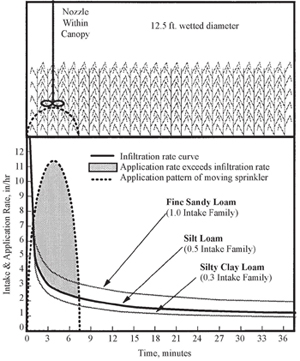 |
|
| Figure 6a. Potential runoff for nozzle located above crop canopy. | Figure 6b. Potential runoff for nozzle located within crop canopy. |
Summary
Simply lowering spray heads from above the crop to within the crop canopy does not make a LEPA system and does not reduce energy costs unless time of operation is reduced. Operating sprinkler devices within the crop canopy distorts the sprinkler devices designed wetted diameter. This results in poor uniformity regardless of nozzle height, and even at a nozzle spacing of 5 feet. A smaller wetted diameter means higher application rates and the increased potential for field runoff. The gains made through improved sprinkler devices and reduced operating pressure can be quickly erased by runoff losses.
Unless specifically designed, low-pressure nozzles on drop tubes should be placed at or above the top of the crop canopy. As the use of low pressure and drop tubes expand, evaluate your system before making changes. If you notice runoff or can see the potential for runoff is close, reducing both pressure and the wetted diameter of the sprinkler device will only make things worse. Your current system may provide the most efficient application of water. Runoff, when not kept at a minimum, will result in increased pumping costs, crop water stress and/or deep percolation water losses.
References
Lamm, F.R. 1997. Uniformity of In-Canopy Center Pivot Sprinkler Application in Fully Developed Corn Canopies. In: Proc. Central Plains Irrigation Short Course. Garden City, KS. Feb. 7-8, 1995. P. 64-72.
Lamm, F.R. 1997. In-Canopy Sprinkler Application for Corn: What Works and What Doesn’t. In: Proc. Central Plains Irrigation Short Course. Colby, KS. Feb. 4, 1997. P. 14-23.
Acknowledgment
The authors would like to acknowledge the contributions of the co-authors of the original edition of this publication: Norman L. Klocke and Kelly Wertz.
| Reference to commercial products or trade names is made with the understanding that no discrimination is intended of those not mentioned and no endorsement by University of Nebraska–Lincoln Extension is implied for those mentioned. |
Visit the University of Nebraska–Lincoln Extension Publications Web site for more publications.
Index: Irrigation Engineering
Irrigation Operations & Management
Issued June 2007
